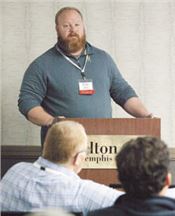Cotton Farmer Of The Year

Adam Chappell, Cabot, Arkansas, has been named the 2020 Cotton Farmer of the Year at the 23rd Annual National Conservation Systems Cotton & Rice Conference, Southern Corn & Soybean Conference, Southern Precision Ag Conference and the Delta States Irrigation Conference.
Chappell has a bachelor’s degree in Botany from Arkansas State and a master’s in entomology from the University of Arkansas. He farms approximately 9,000 acres in partnership with his brother Seth. He is a fourth generation farmer.
“Adam Chappell is an early adopter who isn’t afraid to take on new challenges and to try things that might seem a little ‘out of the box’. Adam is a different kind of farmer. He attends workshops and field days across the nation and rather than saying, ‘that won’t work on my farm’, he sets up and does the research on his farm. He has done many cover crop trials, experimented with adding grazing to his cropping system, dual cropping and some skip row cotton trials just to name a few. Adam has been a huge benefit to NRCS allowing us to use a local example to farmers across the state of Arkansas.”
Chappell shares his passion for farming. “Chappell is perhaps the most innovative producer I have ever had the opportunity to work with. While I enjoy the experiences we share in our research interest, I often feel I gain more knowledge from working with him than he does with me,” stated a colleague.
“There are two basic philosophies for farming. One is to produce more than you spend and the other is to spend less than you make. For far too long producers strive for the highest yields possible often with little consideration of costs. Chappell is clearly focused on spending less than he makes. He has realistic yield goals and has firm knowledge of his expenses. Chappell is not trying to win the yield contest. His clear goal is to win the profitability contest. This is what being sustainable as a producer really means.”
“Chappell’s latest challenge revolves around 76 inch row spacing on cotton. The use of cover crops and their impact on improved soil health is helping to make this a reality. His expenses are very low and he looks forward to seeing how this pans out on his bottom line at harvest end. This topic will be the subject of a session at the 2020 meeting of the Cotton & Rice Conservation Systems meeting.”
“Chappell has been big in the soil health movement and has really changed the way he looks at what he does. He has reduced his irrigation as much as 50%. He planted cotton on 76 inch rows in 2019 and has drastically reduced his use of commercial fertilizer and the amount of herbicides used on his farm.”
“While Chappell is always looking for innovative ways to improve his bottom line, he is always willing to share his knowledge and experience with other producers.” ∆